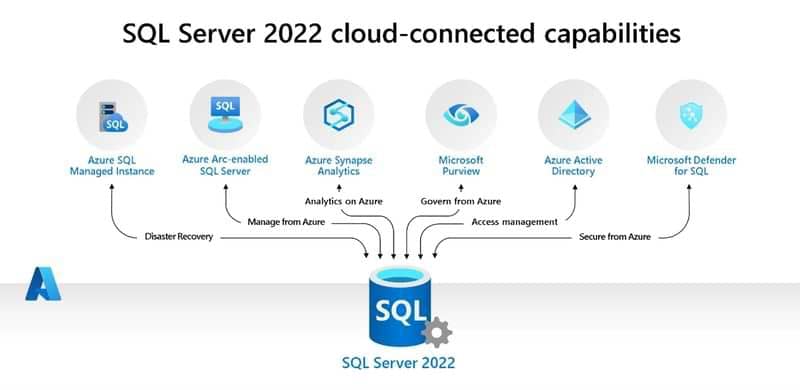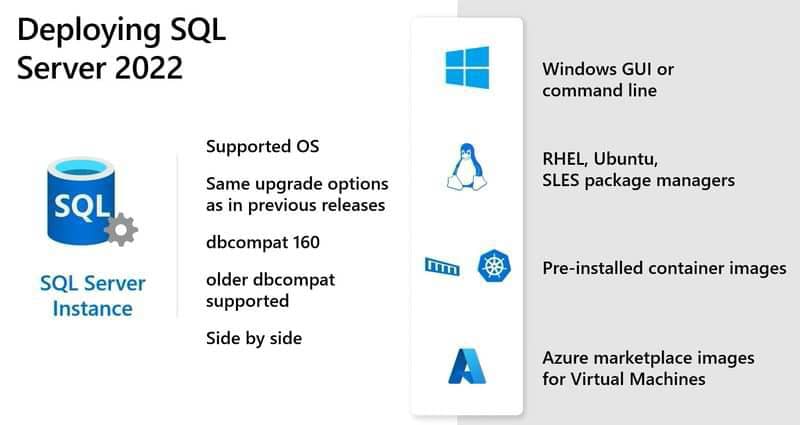The new version of Microsoft's famous RDBMS is closely integrated with Microsoft's cloud services. SQL Server 2022 gains in performance and availability, while offering enhanced security. Here's an overview of what's new.

Available since 16 November, Microsoft SQL Server 2022 is the first major update in three years for Microsoft's famous relational database management system (RDBMS).
Third most popular base in the world according to DB-Engines websiteSQL Server is facing competition from many other systems, such as PostgreSQL, which is also based on the SQL query language, but under an open source licence.
To maintain its lead, SQL Server is being equipped with new weapons. The main one is its integration with Microsoft Azure cloud services. The key to this is faster, easier disaster recovery, data analysis and improved security.
SQL Server moves logically to the cloud
This move to the cloud is natural. Since the launch of SQL Server in 1989, databases have gradually been relocated from the company's servers to the cloud.
This integration with Azure also makes SQL Server 2022 a central building block of the the Intelligent Data Platform approach unveiled by Microsoft. With a view to unification, this platform brings together the databases, analysis and models of governance. The objective is twofold. The aim is to unify information that is often scattered across the company's various departments. In addition, the move to real-time data processing should enable operational and strategic decisions to be taken more quickly.

SQL Server 2022 offers peveral deployment methods
SQL Server 2022 can be installed in a number of ways: from a graphical interface or command line under Windows, from a package manager for Linux systems, from a container image or from the Azure Marketplace. The system can also be deployed by updating an older version of the RDBMS. Backward compatibility dates back to SQL Server 2005.

Disaster recovery made easy
In line with the Intelligent Data Platform concept, SQL Server 2022 will connect to several Azure services, starting with Azure SQL Managed Instance.
As the name suggests, this is a managed instance of the database engine in the cloud. By replicating on-premises data in the cloud, this Plateform as a Service (PaaS) environment guarantees optimum availability for users. As part of a business continuity plan (PCA) or return to work (PRA), enabling disaster recovery. Integration with Azure SQL Managed Instance also offloads the burden of SQL Server 2022 and preserves its performance during heavy queries or when the RDBMS is scaled up. The company also benefits from the managed approach, with Microsoft managing all the configuration and administration. "The instance is ready and waiting whenever you need it, with no configuration or time-consuming maintenance." says Rohan Kumar, Corporate Vice President of Azure Data.
Real-time data analysis
The 2022 edition also facilitates integration into Azure Synapse Analyticsa cloud-based data warehouse service dedicated to data analysis, big data and machine learning. Moving data from local databases, such as SQL Server, to Synapse previously required the use of an ETL (Extract, Transform, Load) tool to extract, transform and load the data, a very time-consuming stage.
Skip the ETL step
To bypass this ETL stage, Microsoft offers a connector called simply Azure Synapse Link for SQL Server 2022. This will take place on role by automatically feeding all changes made in the RDBMS back to Azure Synapse Analytics in real time, while still having "a clear view of what's going on". minimal impact". on the performance of the source database.
This ensures that the latest up-to-date data is available for analytical or machine learning processing. Once the data has been uploaded into Azure Synapse Analytics, it can also be combined with other data sources, " regardless of their size, scale or format".Azure Machine Learning, the open source Apache Spark framework or Power BI, the in-house business intelligence tool.
Compatibility with clouds other than Azure
In the same spirit of openness, SQL Server can be grafted onto the Azure Arc. It will extend Azure services to SQL Server instances hosted outside the Microsoft cloud, in the data centre of the company, in edge computing or in another provider's cloud. Once the Azure for SQL Server extension has been installed, all SQL Server instances are recognised and connected to Azure Arc.
Using blockchain to ensure data integrity
In terms of governance and security, the system connects to Microsoft Purview services, Azure Active Directory and Microsoft Defender for SQL. Microsoft Purview is a solution of data governance that enables data to be managed and governed locally, in the cloud or in SaaS mode in order to ensure compliance with the law. security policy and comply with the regulatory framework.
Azure Active Directory corresponds to Microsoft's famous identity and access management service - a kind of user directory service - but based in the cloud. Azure Active Directory will control access to SQL Server 2022. Microsoft Defender for SQL will protect the database by detecting threats and correcting any errors. vulnerabilities.
Safety has also been enhanced by the introduction of Ledger for SQL Server. This new feature uses blockchain technology for " create a tamper-proof history of all changes made to the database". This approach will guarantee data integrity in the event of an audit or compliance check. This extra protection means that Microsoft is calling SQL Server 2022 " the most secure database in the last ten years.
Finally, alongside perpetual licences and the subscription system, Microsoft is introducing a new billing option: pay-as-you-go for SQL Server 2022 instances managed by Azure Arc. This is a welcome pricing flexibility for businesses that need to manage peaks in activity, particularly when seasonal activity is involved.
ORSYS offers more than 25 training courses on SQL Server, covering the fundamentals of the system as well as its administration, optimisation, SQL programming and data analysis using business intelligence.

